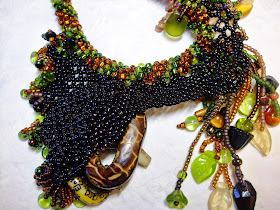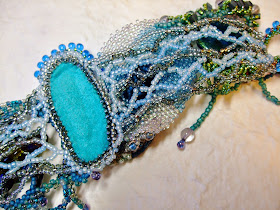First lets define the word freeform - ok, so I know they're using a hyphen, but in my head it's one word. This is from Dictionary.com
Free-form -
1.
characterized by free form:
free-form sculpture.
2.
not organized or planned in a conventional way:
a free-form international conglomerate.
3.
encouraged to function or evolve without advance planning; spontaneous:
free-form management.
4.
without restrictions or preconceptions:
The children were allowed to paint free-form
So freeform beadwork is beadwork that evolves during the creation process. It may or may not be planned in advance, but does not follow a conventional pattern. I often like to say that I bead improvisationally - this spontaneity is at the heart of much of my work, even if I started with a sketch or overall concept. I let the beads tell me what they want to do and how they want to do it. Alright, on to today's episode!
Episode 1: Types of Freeform Beadwork
When you start looking at collections or galleries of freeform beadwork (I love books and Pinterest for this) you will start noticing that it seems like each piece is as unique and beautiful as a snowflake or fingerprint. And they are! However, there are several broad categories that a freeform piece can fall into. Please keep this in mind as you read this - these are simply the terms that I use to keep things straight in my brain. They are by no means industry standard terms. I find it helpful for me to categorize my own work like this, and I am hoping that defining these styles will help you refine your own skills.
Embellishment Freeform -
This is where I started, and I really think it's the easiest type of freeform for a beginner to pick up. Embellishment freeform starts with a foundation (flat or otherwise), and then random embellishments are stitched off of the foundation. The embellishments can consist of anything you can imagine - components, loops, fringes, anything you can dream up. Here are some examples:
This is the very first freeform I ever stitched! You can see all of the embellishment here - I was trying to make an environment for the anaconda to live in.
Here you can see my foundation - alternating between 3-bead netting, 2-drop peyote, and 5-bead netting. I am pretty sure I only knew netting and peyote stitch at this time. This goes to show that you don't need to have a huge stitch repetoire in order to make a freeform piece. Just use whatever stitches you know! Check out these other examples of embellishment freeform for more ideas:
This bracelet is embellished with fringe, components, and art beads.Here you can see the multicolored freeform netting foundation.
This bracelet is embellished with ruffles, short seed fringe, loops, and animal beads.
Here you can see the 5-bead netting foundation that I worked off of.
Bead Soup Freeform -
I am pretty sure the next type of freeform I attempted was bead soup freeform. The best part is making the soup of beads - simply choosing beads to mix together into a large pile, or soup. I like a lot of variety in my soups - the texture of different sizes and shapes is challenging to work with, but the end results are spectacular. Again, you can do any stitch! Simply use your bead soup as you would when stitching with a single color of bead, improvising for different bead sizes as the need arises. This type of freeform is a real lesson in spontaneity...the trick is to figure out how to use the beads on your needle, no matter the side or shape. Here are a few examples:
This is one of my first pieces of bead soup freeform (ew, see that big fat knot? I've come so far!). I made a whole bunch of these one year as brooches for my aunties. In the beginning it's really hard to control the shape of a bead soup freeform...all of my early pieces had this flare, from increasing the bead count in each row.
Ah, Christmas beads, oh how I love thee... This fun bag is stitched in tubular peyote. At this point, I had gotten much more skilled at controlling the shape of a piece.
I made this bead soup freeform just this week. In this case, I went into it knowing that I wanted the end results to be organically shaped, so I just embraced what the beads wanted to do!
Bridge and Patch Freeform -
This style is probably what most people think of when freeform beadwork is mentioned. It can be open and lacy, or dense and textural, but the piece should consist of patches of the same bead along with bridge like transitions from one part of the beadwork to another.
This watch is the first bridge and patch freeform I ever stitched. This is a good example of a densely stitched piece - the bridges are single strands of larger sized beads, filling in the negative space. Each patch of color or different type of bead transitions into the next, and even though there is a lot going on, everything comes together to form a cohesive whole.
Here is a more recent example of a more open bridge and patch freeform. While I still have some single strand bridges, there are also stitched bridges in this piece.
This is one of my most recent experiments in bridge and patch freeform. You can see with this piece, I have very few single strand bridges...nearly all of them are stitched. I like how structural this piece turned out.
Encrusting Freeform -
Any time I stitch over and around a form (also known as an armature), capturing it with beads, I think of it as encrusting freeform. I make my own polymer clay components to encrust, but I've also worked over other items. I've seen a lot of really cool encrusted rocks, bones, dishes...etc. The possibilities are endless!
This a piece of tumbled petrified wood. When I saw it I knew it would be a perfect pendant for my boyfriend...but it had no hole. No problem, says I, I'll just bead around it! I did as minimal of an encrustation as I could, particularly on the front, so you can see as much of the stone as possible.
On the back it was necessary to stitch a few bridges to keep the stone from falling out.
Tentacle Baby is a much more complex encrustation freeform.
Any time I stitch over and around a form (also known as an armature), capturing it with beads, I think of it as encrusting freeform. I make my own polymer clay components to encrust, but I've also worked over other items. I've seen a lot of really cool encrusted rocks, bones, dishes...etc. The possibilities are endless!
This a piece of tumbled petrified wood. When I saw it I knew it would be a perfect pendant for my boyfriend...but it had no hole. No problem, says I, I'll just bead around it! I did as minimal of an encrustation as I could, particularly on the front, so you can see as much of the stone as possible.
On the back it was necessary to stitch a few bridges to keep the stone from falling out.
Tentacle Baby is a much more complex encrustation freeform.
Component Freeform -
This is probably the type of freeform I do the most. It consists of stitching multiple different freeform elements together to create a whole.
Man in the Machine has several of my encrusted cabochons, plus a strap of bridge and patch freeform going up one side.
This piece came about in a way that many of my component freeforms do... I made components for a few different projects and ended up not using them. Much later, going through my (giant) box of WIP's, I realized that several of them coordinated. Then comes the fun parts - laying them out in different configurations and figuring out how to attach them all together. Make a few extra components or embellishments to complete the whole thing, and voila! A freeform is born!
Sculptural Freeform -
No pictures for this one yet...I'll work on it! Sculptural freeform can be very similar to encrusting freeform, a dimensional beaded form, but without the armature that encrusting freeform has.
Here are a few more notes to think about:
- You can freeform ANY stitch...one stitch may do what you want better than others.
- You can combine multiple stitches in one piece.
- You can freeform with any beads...though some may be more appropriate to your project than others. Straight sided beads make curves difficult...yes, I am talking about Delicas. Remember those Czech beads you have stashed away because they won't stay flat like your Delicas will? Break them out for freeform.
- You can combine multiple types of freeform. For example, you can make a bead soup freeform that has bridges, or (like Man in the Machine) combine your encrusting freeforms into a single piece.
Your own mind is your only limitation when it comes to freeform - the possibilities really are endless. What aspect of freeform should I discuss in the next chapter? Do you have any requests?
You can keep up with my daily bead exploits on my Facebook page, or shop on Etsy. As always, thanks for looking!
No pictures for this one yet...I'll work on it! Sculptural freeform can be very similar to encrusting freeform, a dimensional beaded form, but without the armature that encrusting freeform has.
Here are a few more notes to think about:
- You can freeform ANY stitch...one stitch may do what you want better than others.
- You can combine multiple stitches in one piece.
- You can freeform with any beads...though some may be more appropriate to your project than others. Straight sided beads make curves difficult...yes, I am talking about Delicas. Remember those Czech beads you have stashed away because they won't stay flat like your Delicas will? Break them out for freeform.
- You can combine multiple types of freeform. For example, you can make a bead soup freeform that has bridges, or (like Man in the Machine) combine your encrusting freeforms into a single piece.
Your own mind is your only limitation when it comes to freeform - the possibilities really are endless. What aspect of freeform should I discuss in the next chapter? Do you have any requests?
You can keep up with my daily bead exploits on my Facebook page, or shop on Etsy. As always, thanks for looking!

















HOLY WOW! I still look at freeform as a swear word but I love how you make it work!
ReplyDeleteI firmly believe that if you are attracted to freeform, you should try it. If you aren't then that's ok too! Everyone has their niche, and this is definitely mine. I would pull my hair out trying to do what you do!
Deletehi just wanted to thank you for encouraging me to pick up a bead and needle again. I lost my creativity after my husband died in marh and I have not felt able to create since. Yes I can bead follow patterns ect but not do what I love to do that is freeform. So thanks for the inspiration and encouragement to have a go.
ReplyDeletethanks